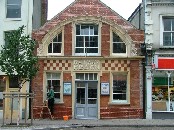| |
|
Railway
Mission, Norwich (Prince of Wales Road Evangelical Church)
 |
|
As
with most East Anglian towns and cities, the
railway station in Norwich was built outside of
the immediate centre because its main use was not
for passengers, but for goods, especially
livestock, which needed space to be penned nearby
until the time for their journey began. There was
another station on a different line closer to the
city centre, but it is Thorpe station that has
survived. As in Cambridge and Ipswich, where the
main station was similarly placed for the same
reason, the area became home to dozens of rows of
terraced houses, for workers on the railway and
in the industries that the presence of the line
generated. |
Although
the Church of England was not slow to respond to what it
saw as the pastoral needs of these workers, there were
plenty of other denominations elbowing for their
attention. For a start, many incomers were Catholics, and
it was in the 19th century that the Catholic population
of the city ballooned. But it was also the time that the
congregational chapels took off, and although many of
them have fallen prey to demolition in recent decades,
there are some interesting survivals, including this
little Railway Mission chapel of the 1890s with its Art
Nouveau frontage. Prince of Wales Road, like Princes
Street in Ipswich, was built specifically to connect the
railway station with the heart of the town, and still
today this chapel is a familiar sight for pedestrians en
route between one and the other. Happily, it is still in
use for its original purpose; as the Prince of Wales Road
Evangelical Church, it maintains two services every
Sunday.
Simon Knott, November 2005
|
|
|
